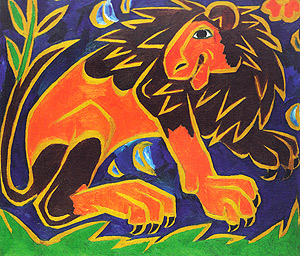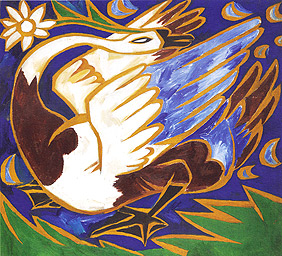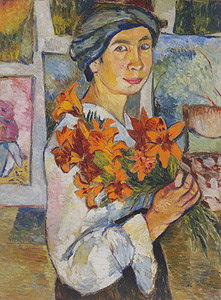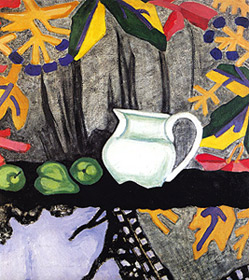"Absolutely, I’m not a European. Eureka"
Natalia Goncharova
We are extremely fortunate, my friends in the epoch:
From October 16, 2013 through February 16, 2014, exhibition "Natalia Goncharova. Between East and West" is open at the Exhibition Halls of the Tretyakov Gallery, Crymskiy Val Str., 10.
You do need to see the exhibition.
The name of Natalia Sergeevna Goncharova is well known to every artist who respects him or herself; and everyone who has seen Goncharova’s works once will have them imprinted on their hearts as deeply and stubbornly as Nefertiti’s profile, or "Trinity" by Andrey Rublev, of La Gioconda’s smile.
In 1913, the Tretyakov Gallery purchased two paintings by Goncharova for the first time.
And now, one hundred years later, the most comprehensive display of the works by the artist is presented to the public. At the exhibition, the works by Goncharova from Russian museums, from France and Germany, from private collections located in various countries are displayed; although the golden core of the exposition is the collection coming from the Tretyakovka’s stocks. And thank God it is like that; indeed, it is a sign from on high. It’s true, Natalia Goncharova left Russia together with Mikhail Larionov in 1915, and we shall not speculate why. Perhaps it happened because her paintings had been often “arrested” at exhibitions in Russia falling victims to endless disputes "Luchism-Futurism-Cubism", or just because Dyagilev helped out there in Europe. Oh that Dyagilev! If it hadn’t been for him, in Europe they would have known nothing of us except maybe "balalaikas" and "matreshkas". In any case, Natalia Goncharova’s both life and career were much more successful than, for instance, the fate of another "amazon of Russian avant-garde" – Olga Rozanova.
Traditionally, they call women in arts "Amazons", perhaps for the fact that they have to fight constantly for their right to create alongside with "centaurs", "titans" and "greek heroes". But they have never really fought with the "Olympians": strangely enough, there were gods and goddesses in about equal proportions on mount Olympus.
Amazingly, Olga Rozanova was born on the same day as Natalia Goncharova, but the difference made five years:
Natalia Sergeevna Goncharova was born on the 21st of June (3 July), 1881, in Tula Gubernia (Province),
Olga Vladimirovna Rozanova was born on the 21 June (3 July), 1886, in Vladimir Gubernia (Province).
Last summer I was happy to look with my own eyes at one work by Olga Rozanova exhibited in the Art Museum named after Radishchev; until then I had known it only by reproductions. And I was not disappointed.
Olga Rozanova was both a remarkable artist and a leading theorist of the new art of the XXth century. And think of those people around! V. Khlebnikov, K. Malevich, Vladimir Mayakovsky, A. Kruchenykh finally her closest friend and in a way the partner in life.
I really assume that the famous exhibition of Natalia Goncharova’s works in 1913, where she presented 750 pieces, and when critics swooped onto her while Alexander Benua supported her, and Grabar purchased those two first paintings for the Tratyakovka’s collection, couldn’t help inspiring Olga Rozanova to feat; the story sure keeps inspiring us today.
But then difference comes:
it’s the incredible power and Natalia Goncharova’s ability for work: no joke, 750 works for 13 years!
"Goncharova, this word then sounded victory", - Tsvetayeva said.
Olga Vladimirovna Rozanova died of diphtheria when she was 32, in 1918 in Moscow. Natalia Sergeevna Goncharova lived to be 81, she kept drawing and painting up to the very end. She died in 1962, but in Paris.
Goncharova’s palette came to be much more discreet in colour when she moved to Europe.
It seemed the most interesting to me, for we always notice something, especially what we take to heart, and I had always shifted to the colours that sounded more discreet and closer to each other in my European cycles.
No matter how beautiful Goncharova’s «Spaniard Girls» might be,
spectators feel even if not see,
that it was not the main thing in her artistic search.
And no matter how delighted they were with the artist’s objectless painting
(for instance, her «Bathing Girls» have won my heart),
everyone would say it’s not this that makes the nature of Goncharova’s art.
The very colorization of display exposition stands strikes out thecore:
both maximum colour saturation,
and maximum laconism and expressiveness of images
was achieved by the Russian artist only when she
put her feet onto our ground, our vast and generous, miserable and unsettled native land.
And in that the mystery roots.


N.S. GONCHAROVA «LION» И «SWAN» parts of polyptych «VINTAGE»,
from the Tretyakov State Gallery collection
Russia spreads between East and West as is crucified.
You can’t hide yourself from the fact, you can’t leave it, walk away or drive to somewhere else, or take a flight to Tahiti.
That is why you should visit the exhibition of Natalia Goncharova’s works
if you have not visited it yet.
You should visit it again if you have.
You shall find here things to be delighted with, to think about and to learn.
Goncharova – even now the name sounds victory.


